Page 243 of 297
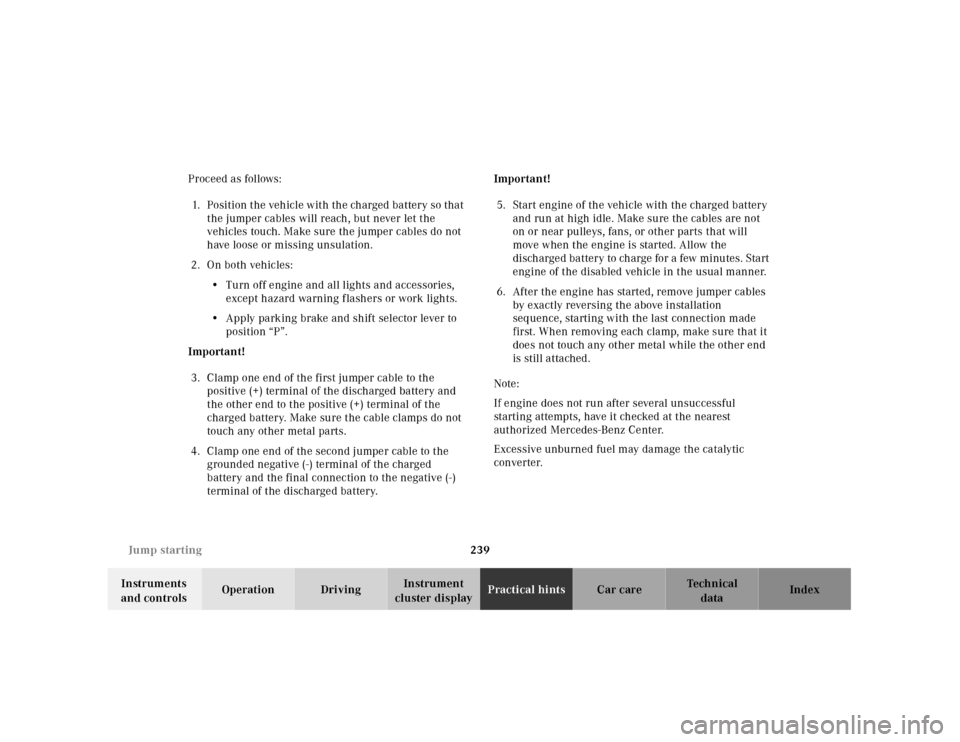
239 Jump starting
Technical
data Instruments
and controlsOperation DrivingInstrument
cluster displayPractical hintsCar care Index Proceed as follows:
1. Position the vehicle with the charged battery so that
the jumper cables will reach, but never let the
vehicles touch. Make sure the jumper cables do not
have loose or missing unsulation.
2. On both vehicles:
• Turn off engine and all lights and accessories,
except hazard warning flashers or work lights.
• Apply parking brake and shift selector lever to
position “P”.
Important!
3. Clamp one end of the first jumper cable to the
positive (+) terminal of the discharged battery and
the other end to the positive (+) terminal of the
charged battery. Make sure the cable clamps do not
touch any other metal parts.
4. Clamp one end of the second jumper cable to the
grounded negative (-) terminal of the charged
battery and the final connection to the negative (-)
terminal of the discharged battery.Important!
5. Start engine of the vehicle with the charged battery
and run at high idle. Make sure the cables are not
on or near pulleys, fans, or other parts that will
move when the engine is started. Allow the
disch arge d ba ttery to ch arge for a few minu tes. Sta rt
engine of the disabled vehicle in the usual manner.
6. After the engine has started, remove jumper cables
by exactly reversing the above installation
sequence, starting with the last connection made
first. When removing each clamp, make sure that it
does not touch any other metal while the other end
is still attached.
Note:
If engine does not run after several unsuccessful
starting attempts, have it checked at the nearest
authorized Mercedes-Benz Center.
Excessive unburned fuel may damage the catalytic
converter.
Page 245 of 297
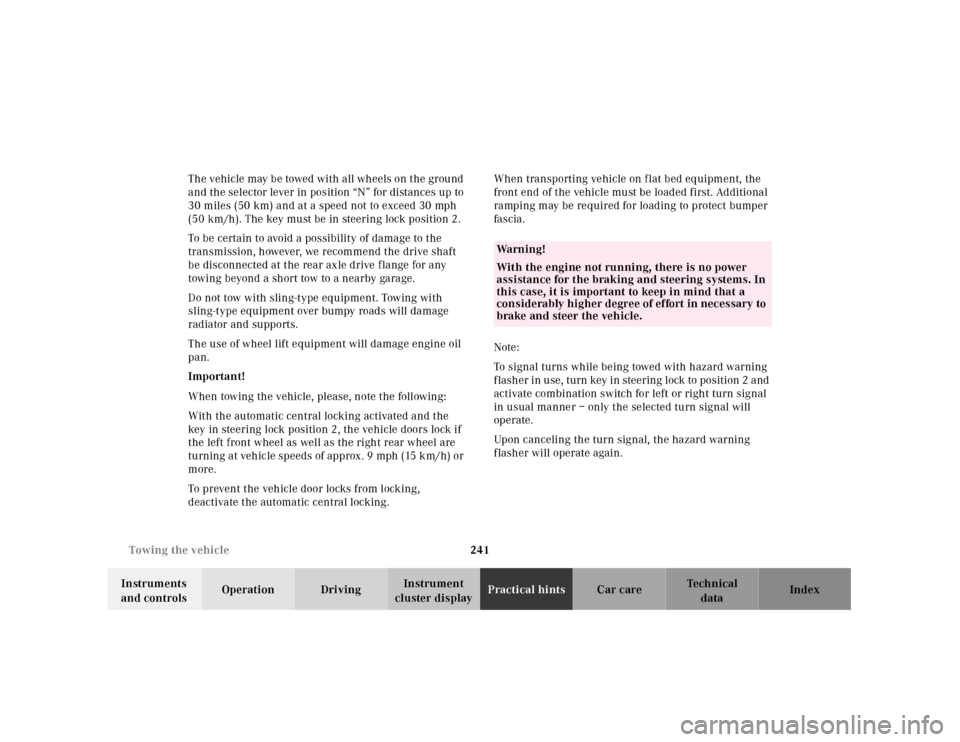
241 Towing the vehicle
Technical
data Instruments
and controlsOperation DrivingInstrument
cluster displayPractical hintsCar care Index The vehicle may be towed with all wheels on the ground
and the selector lever in position “N” for distances up to
30 miles (50 km) and at a speed not to exceed 30 mph
(50 km/h). The key must be in steering lock position 2.
To be certain to avoid a possibility of damage to the
transmission, however, we recommend the drive shaft
be disconnected at the rear axle drive f lange for any
towing beyond a short tow to a nearby garage.
Do not tow with sling-type equipment. Towing with
sling-type equipment over bumpy roads will damage
radiator and supports.
The use of wheel lift equipment will damage engine oil
pan.
Important!
When towing the vehicle, please, note the following:
With the automatic central locking activated and the
key in steering lock position 2, the vehicle doors lock if
the left front wheel as well as the right rear wheel are
tu rning a t veh ic le speeds of approx . 9 mph (15 k m/h) or
more.
To prevent the vehicle door locks from locking,
deactivate the automatic central locking.When transporting vehicle on flat bed equipment, the
front end of the vehicle must be loaded first. Additional
ramping may be required for loading to protect bumper
fascia.
Note:
To signal turns while being towed with hazard warning
f lash er in u se, turn key in steering l ock to position 2 a nd
activate combination switch for left or right turn signal
in usual manner – only the selected turn signal will
operate.
Upon canceling the turn signal, the hazard warning
f lasher will operate again.
Wa r n i n g !
With the engine not running, there is no power
assistance for the braking and steering systems. In
this case, it is important to keep in mind that a
considerably higher degree of effort in necessary to
brake and steer the vehicle.
Page 264 of 297
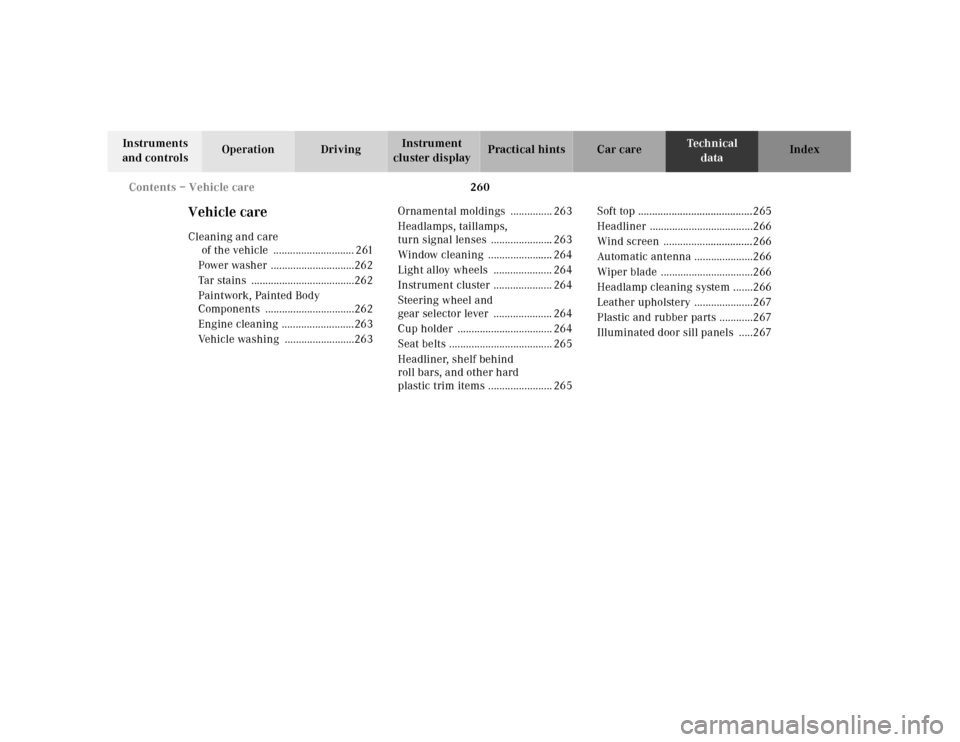
260 Contents – Vehicle care
Technical
data Instruments
and controlsOperation DrivingInstrument
cluster displayPractical hints Car care Index
Vehicle careCleaning and care
of the vehicle ............................. 261
Power washer ..............................262
Tar stains .....................................262
Paintwork, Painted Body
Components ................................262
Engine cleaning ..........................263
Vehicle washing .........................263Ornamental moldings ............... 263
Headlamps, taillamps,
turn signal lenses ...................... 263
Window cleaning ....................... 264
Light alloy wheels ..................... 264
Instrument cluster ..................... 264
Steering wheel and
gear selector lever ..................... 264
Cup holder .................................. 264
Seat belts ..................................... 265
Headliner, shelf behind
roll bars, and other hard
plastic trim items ....................... 265Soft top .........................................265
Headliner .....................................266
Wind screen ................................266
Automatic antenna .....................266
Wiper blade .................................266
Headlamp cleaning system .......266
Leather upholstery .....................267
Plastic and rubber parts ............267
Illuminated door sill panels .....267
Page 267 of 297
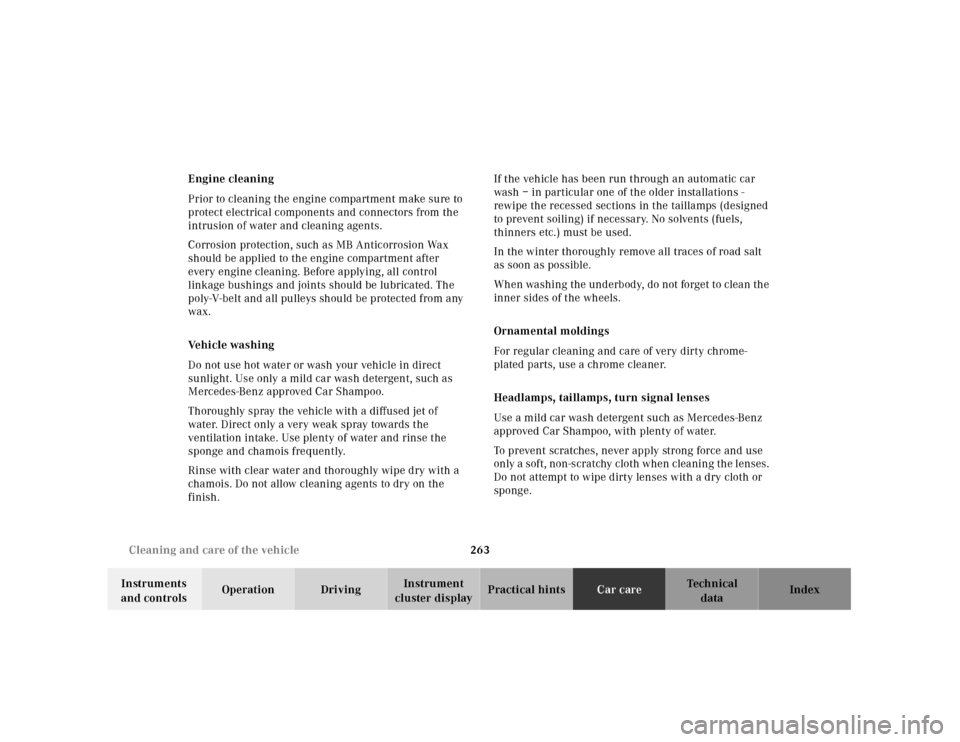
263 Cleaning and care of the vehicle
Technical
data Instruments
and controlsOperation DrivingInstrument
cluster displayPractical hintsCar careIndex Engine cleaning
Prior to cleaning the engine compartment make sure to
protect electrical components and connectors from the
intrusion of water and cleaning agents.
Corrosion protection, such as MB Anticorrosion Wax
should be applied to the engine compartment after
every engine cleaning. Before applying, all control
linkage bushings and joints should be lubricated. The
poly-V-belt and all pulleys should be protected from any
wax.
Ve h i c l e w a s h i n g
Do not use hot water or wash your vehicle in direct
sunlight. Use only a mild car wash detergent, such as
Mercedes-Benz approved Car Shampoo.
Thoroughly spray the vehicle with a diffused jet of
water. Direct only a very weak spray towards the
ventilation intake. Use plenty of water and rinse the
sponge and chamois frequently.
Rinse with clear water and thoroughly wipe dry with a
chamois. Do not allow cleaning agents to dry on the
finish.If the vehicle has been run through an automatic car
wash – in particular one of the older installations -
rewipe the recessed sections in the taillamps (designed
to prevent soiling) if necessary. No solvents (fuels,
thinners etc.) must be used.
In the winter thoroughly remove all traces of road salt
as soon as possible.
When washing the underbody, do not forget to clean the
inner sides of the wheels.
Ornamental moldings
For regular cleaning and care of very dirty chrome-
plated parts, use a chrome cleaner.
Headlamps, taillamps, turn signal lenses
Use a mild car wash detergent such as Mercedes-Benz
approved Car Shampoo, with plenty of water.
To prevent scratches, never apply strong force and use
only a soft, non-scratchy cloth when cleaning the lenses.
Do not attempt to wipe dirty lenses with a dry cloth or
sponge.
Page 272 of 297
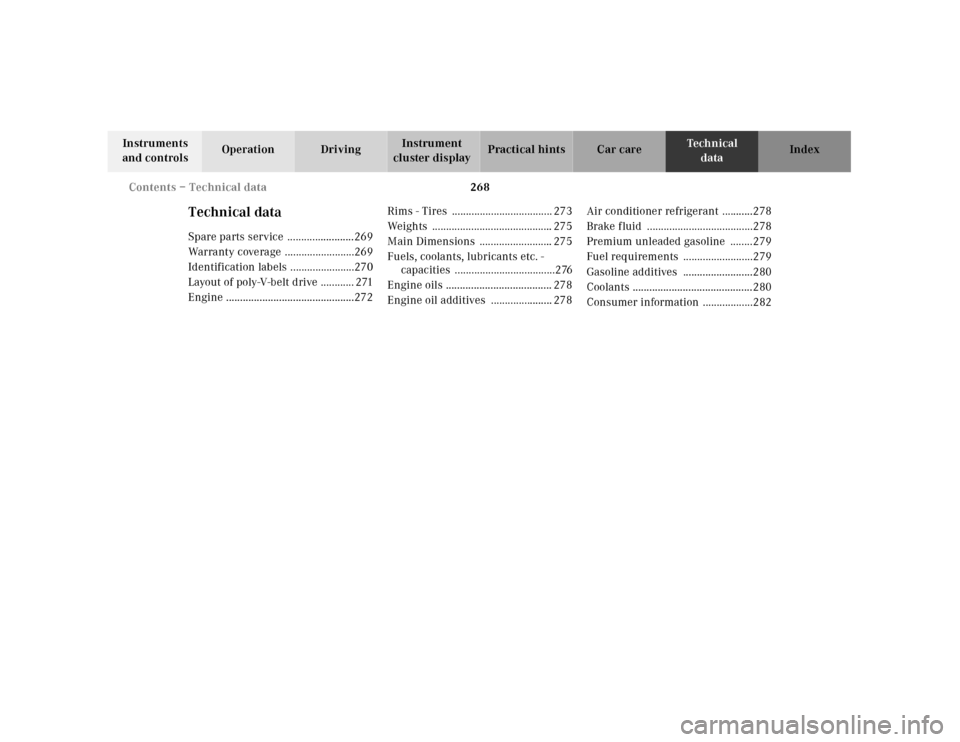
268 Contents – Technical data
Technical
data Instruments
and controlsOperation DrivingInstrument
cluster displayPractical hints Car care Index
Technical dataSpare parts service ........................269
Warranty coverage .........................269
Identification labels .......................270
Layout of poly-V-belt drive ............ 271
Engine ..............................................272Rims - Tires .................................... 273
Weights ........................................... 275
Main Dimensions .......................... 275
Fuels, coolants, lubricants etc. -
capacities ....................................276
Engine oils ...................................... 278
Engine oil additives ...................... 278Air conditioner refrigerant ...........278
Brake fluid ......................................278
Premium unleaded gasoline ........279
Fuel requirements .........................279
Gasoline additives .........................280
Coolants ...........................................280
Consumer information ..................282
Page 274 of 297
270 Technical data
Technical
data Instruments
and controlsOperation DrivingInstrument
cluster displayPractical hints Car care Index
Identification labels
1Certification label
(left door pillar)
Note:
When ordering spare parts, please specify vehicle
identification and engine numbers.2VIN, visible (lower edge of windshield)
3Vehicle Identification No. (VIN)
4Engine number
5Body number and paintwork number
6Emission control label
7Information label
California version
Vacuum line routing for emission control system
Page 276 of 297
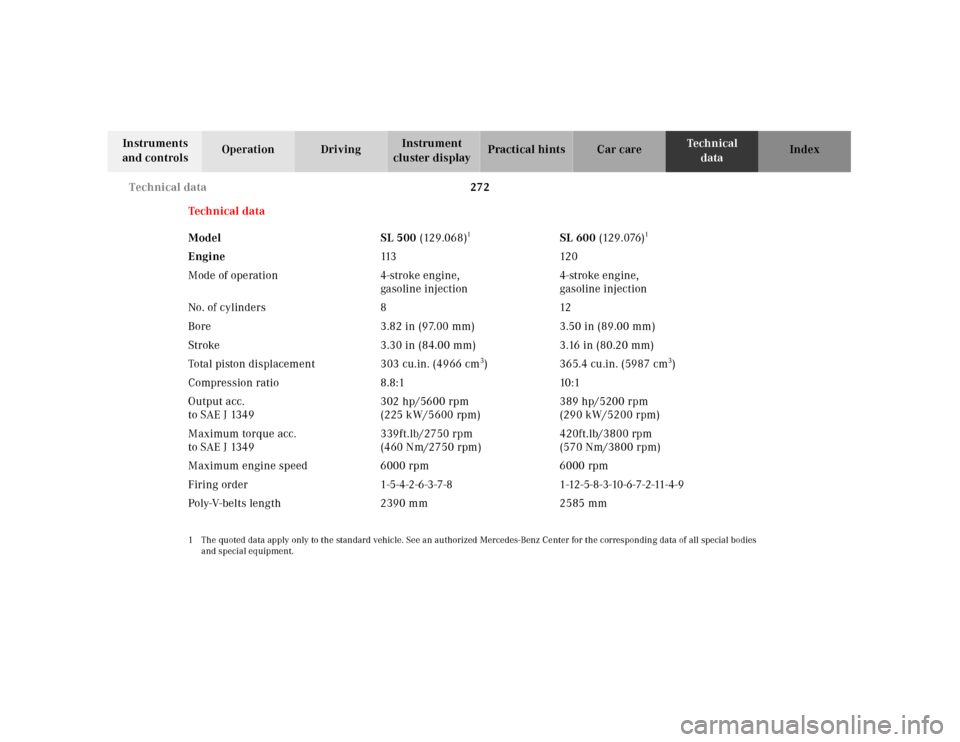
272 Technical data
Technical
data Instruments
and controlsOperation DrivingInstrument
cluster displayPractical hints Car care Index
Technical data
Model SL 500 (129.068)
1
SL 600 (129.076)
1
Engine113 1 2 0
Mode of operation 4-stroke engine,
gasoline injection4-stroke engine,
gasoline injection
No. of cylinders 8 12
Bore 3.82 in (97.00 mm) 3.50 in (89.00 mm)
Stroke 3.30 in (84.00 mm) 3.16 in (80.20 mm)
Total piston displacement 303 cu.in. (4966 cm
3) 365.4 cu.in. (5987 cm
3)
Compression ratio 8.8:1 10:1
Output acc.
to SAE J 1349302 hp/5600 rpm
(225 kW/5600 rpm)389 hp/5200 rpm
(290 kW/5200 rpm)
Maximum torque acc.
to SAE J 1349339ft.lb/2750 rpm
(460 Nm/2750 rpm)420ft.lb/3800 rpm
(570 Nm/3800 rpm)
Maximum engine speed 6000 rpm 6000 rpm
Firing order 1-5-4-2-6-3-7-8 1-12-5-8-3-10-6-7-2-11-4-9
Poly-V-belts length 2390 mm 2585 mm
1 The quoted data apply only to the standard vehicle. See an authorized Mercedes-Benz Center for the corresponding data of all special bodies
and special equipment.
Page 280 of 297
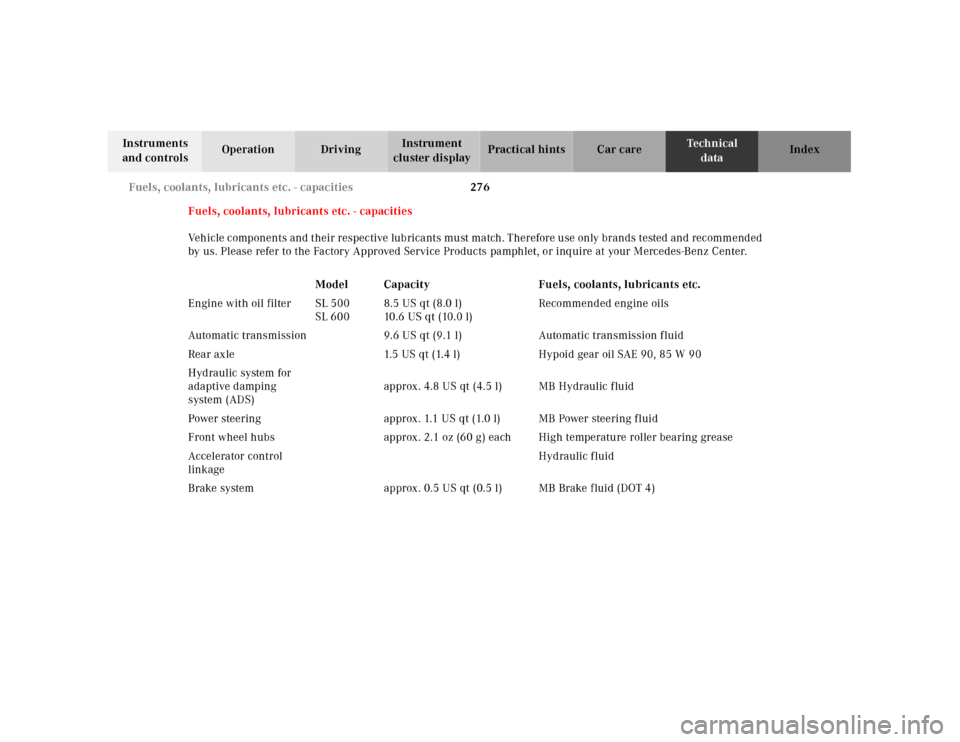
276 Fuels, coolants, lubricants etc. - capacities
Technical
data Instruments
and controlsOperation DrivingInstrument
cluster displayPractical hints Car care Index
Fuels, coolants, lubricants etc. - capacities
Veh icle c omponents and t heir respec tive lub rica nts mu st ma tch . T herefore u se only brands tested and rec omm end ed
by us. Please refer to the Factory Approved Service Products pamphlet, or inquire at your Mercedes-Benz Center.
Model Capacity Fuels, coolants, lubricants etc.
Engine with oil filter SL 500
SL 6008.5 US qt (8.0 l)
10 . 6 U S q t ( 10 . 0 l )Recommended engine oils
Automatic transmission 9.6 US qt (9.1 l) Automatic transmission fluid
Rear axle 1.5 US qt (1.4 l) Hypoid gear oil SAE 90, 85 W 90
Hydraulic system for
adaptive damping
system (ADS)approx. 4.8 US qt (4.5 l) MB Hydraulic fluid
Power steering approx. 1.1 US qt (1.0 l) MB Power steering fluid
Front wheel hubs approx. 2.1 oz (60 g) each High temperature roller bearing grease
Accelerator control
linkageHydraulic fluid
Brake system approx. 0.5 US qt (0.5 l) MB Brake fluid (DOT 4)